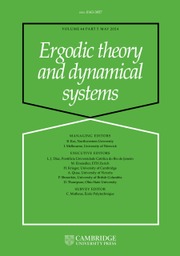Article contents
Classifying orbits of the affine group over the integers
Published online by Cambridge University Press: 22 July 2015
Abstract
For each  $n=1,2,\ldots ,$ let
$n=1,2,\ldots ,$ let  $\text{GL}(n,\mathbb{Z})\ltimes \mathbb{Z}^{n}$ be the affine group over the integers. For every point
$\text{GL}(n,\mathbb{Z})\ltimes \mathbb{Z}^{n}$ be the affine group over the integers. For every point  $x=(x_{1},\ldots ,x_{n})\in \mathbb{R}^{n}$ let
$x=(x_{1},\ldots ,x_{n})\in \mathbb{R}^{n}$ let  $\text{orb}(x)=\{\unicode[STIX]{x1D6FE}(x)\in \mathbb{R}^{n}\mid \unicode[STIX]{x1D6FE}\in \text{GL}(n,\mathbb{Z})\ltimes \mathbb{Z}^{n}\}.$ Let
$\text{orb}(x)=\{\unicode[STIX]{x1D6FE}(x)\in \mathbb{R}^{n}\mid \unicode[STIX]{x1D6FE}\in \text{GL}(n,\mathbb{Z})\ltimes \mathbb{Z}^{n}\}.$ Let  $G_{x}$ be the subgroup of the additive group
$G_{x}$ be the subgroup of the additive group  $\mathbb{R}$ generated by
$\mathbb{R}$ generated by  $x_{1},\ldots ,x_{n},1$ . If
$x_{1},\ldots ,x_{n},1$ . If  $\text{rank}(G_{x})\neq n$ then
$\text{rank}(G_{x})\neq n$ then  $\text{orb}(x)=\{y\in \mathbb{R}^{n}\mid G_{y}=G_{x}\}$ . Thus,
$\text{orb}(x)=\{y\in \mathbb{R}^{n}\mid G_{y}=G_{x}\}$ . Thus,  $G_{x}$ is a complete classifier of
$G_{x}$ is a complete classifier of  $\text{orb}(x)$ . By contrast, if
$\text{orb}(x)$ . By contrast, if  $\text{rank}(G_{x})=n$ , knowledge of
$\text{rank}(G_{x})=n$ , knowledge of  $G_{x}$ alone is not sufficient in general to uniquely recover
$G_{x}$ alone is not sufficient in general to uniquely recover  $\text{orb}(x)$ ; as a matter of fact,
$\text{orb}(x)$ ; as a matter of fact,  $G_{x}$ determines precisely
$G_{x}$ determines precisely  $\max (1,\unicode[STIX]{x1D719}(d)/2)$ different orbits, where
$\max (1,\unicode[STIX]{x1D719}(d)/2)$ different orbits, where  $d$ is the denominator of the smallest positive non-zero rational in
$d$ is the denominator of the smallest positive non-zero rational in  $G_{x}$ and
$G_{x}$ and  $\unicode[STIX]{x1D719}$ is the Euler function. To get a complete classification, rational polyhedral geometry provides an integer
$\unicode[STIX]{x1D719}$ is the Euler function. To get a complete classification, rational polyhedral geometry provides an integer  $1\leq c_{x}\leq \max (1,d/2)$ such that
$1\leq c_{x}\leq \max (1,d/2)$ such that  $\text{orb}(y)=\text{orb}(x)$ if and only if
$\text{orb}(y)=\text{orb}(x)$ if and only if  $(G_{x},c_{x})=(G_{y},c_{y})$ . Applications are given to lattice-ordered abelian groups with strong unit and to AF
$(G_{x},c_{x})=(G_{y},c_{y})$ . Applications are given to lattice-ordered abelian groups with strong unit and to AF  $C^{\ast }$ -algebras.
$C^{\ast }$ -algebras.
Information
- Type
- Research Article
- Information
- Copyright
- © Cambridge University Press, 2015
References
- 10
- Cited by

